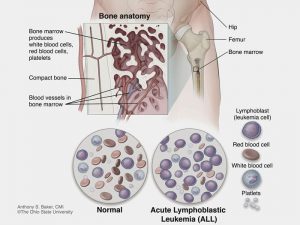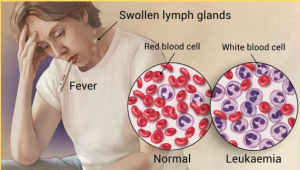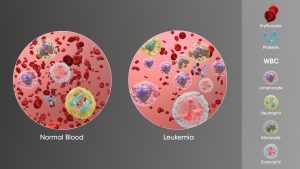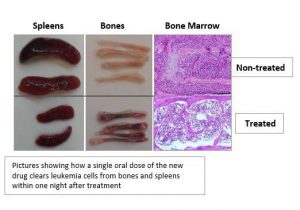LOW KEY MIA!!!
Leukemia is a type of a blood cancer that begins in a bone marrow cell which affects the bone marrow and the blood.This is because the bone marrow produces blood cells and while creating new cells the DNA of immature blood cells, mainly white cells, becomes damaged in some way.This causes the blood cells to grow and divide continuously, so that there are too many.Healthy blood cells die after a while and are replaced by new cells, which are produced in the bone marrow.The abnormal blood cells do not die when they should. They occupy more space as more cancer cells are produced, the healthy white blood cells stop from growing and functioning normally, by crowding out space in the blood.

Some symptoms on individuals can be:-
- Fever, chills, night sweats and other flu-like symptoms,Weakness and fatigue,Swollen or bleeding gums,Headaches,Enlarged liver and spleen,Swollen tonsils,Bone pain,Paleness,Pinhead-size red spots on the skin,Weight loss
- Poor blood clotting: Immature white blood cells crowd out platelets, which are crucial for blood clotting. This means leukemia can be a cause for loss of blood due to poor blood clotting.
- Frequent infections: The white blood cells are important for fighting off infection. If these are not working properly, frequent infections can take place.The immune system may attack other good body cells.
- Anemia: As the shortage of good red blood cells grows, anemia can result. This can involve difficult or labored breathing and pale skin.
Due to these factors a doctor can suspect leukemia.
Some symptoms on the society:-

A person is infected ..the DNA of the bone marrow is damaged.If this passes onto the generation genetically it will affect all the next generation.So people will be more aware of this disease and will start taking precautions. Both children and adults can get leukemia, which is a complex disease with many different types and subtypes.
It is most likely to affect people over the age of 55 years, but it is also the most common cancer in those aged under 15 years.In India most of the population is under the age of 15 years or 55 years.Which is not a advantage in this case as the chances of the disease to spread is higher as the population is very high.
Diagnose-
Your health history is a record of your symptoms, risk factors and all the medical events and problems you have had in the past. In taking a health history, your doctor will ask questions about a personal history of:
- Physical exam. Your doctor will look for physical signs of leukemia, such as pale skin from anemia, swelling of your lymph nodes, and enlargement of your liver and spleen.
- Exposure to high levels of radiation
- Repeated exposure to certain chemicals (for example,benzene)
- Previous Chemotherapy,Down Syndrome
- A strong family history of leukemia
- Blood tests. By looking at a sample of your blood, your doctor can determine if you have abnormal levels of red or white blood cells or platelets — which may suggest leukemia.
Complete blood count (CBC)

This image shows the difference between the normal cells and leukemia cells.
- Bone marrow test.Your doctor may recommend a procedure to remove a sample of bone marrow from your hip bone. The bone marrow is removed using a long, thin needle. The sample is sent to a laboratory to look for leukemia cells. Specialized tests of your leukemia cells may reveal certain characteristics that are used to determine your treatment options.
Other systems that could be affected.
It can then spread to other parts of the body, such as the lymph nodes, spleen, liver, central nervous system and other organs.
Common treatments used to fight leukemia include:
- Chemotherapy. Chemotherapy is the major form of treatment for leukemia. This drug treatment uses chemicals to kill leukemia cells.
drugs may come in a pill form, or they may be injected directly into a vein. - Biological therapy. Biological therapy works by using treatments that help your immune system recognize and attack leukemia cells.
- Targeted therapy. Targeted therapy uses drugs that attack specific vulnerabilities within your cancer cells.

- Radiation therapy. Radiation therapy uses X-rays or other high-energy beams to damage leukemia cells and stop their growth. During radiation therapy, you lie on a table while a large machine moves around you, directing the radiation to precise points on your body.
You may receive radiation in one specific area of your body where there is a collection of leukemia cells, or you may receive radiation over your whole body. Radiation therapy may be used to prepare for a stem cell transplant. - Stem cell transplant. A stem cell transplant is a procedure to replace your diseased bone marrow with healthy bone marrow.
Before a stem cell transplant, one can receive high doses of chemotherapy or radiation therapy to destroy the diseased bone marrow. Then one will receive an infusion of blood-forming stem cells that help to rebuild your bone marrow.
One may receive stem cells from a donor, or in some cases one may may be able to use your own stem cells. A stem cell transplant is very similar to a bone
Here are some ethical and economical effects of the same.
economical-The average cost of an allogeneic bone marrow transplant in the United States is around $800,000.This high cost isnt affordable for poor people and middle class people and in India most of the population is middle class.For them it won’t be possible to invest so much for bone marrow transplant.
Ethical-People who are actually in need sometimes do not get the treatment on time when they apply for transplants as rich people purposely feed the doctors with more money to get their treatment done before.However this process is one of the moral rights for every person on the earth.
To conclude this blog post takes about WHAT,WHY,HOW OF THE DISEASE LEUKEMIA AND HOW TO TREAT IT!!